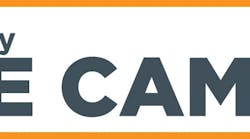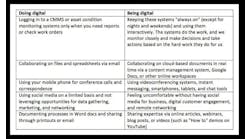Obstacle vs. solution: A digital tranformation implementation guide
Digital transformation isn't rocket science...it's harder!
That mindset isn’t held solely by those figuring out how to take first steps in their digitalization journey. Veterans concur. Consider the response from Carrier Corporation’s Kimberley Hagerty when asked about the greatest current obstacle to digital transformation.
“That’s a tough one,” replied the director of digital transformation manufacturing operations. “Lack of strategy? Denial and lack of digital literacy? It’s really hard to pick just one since they are all interconnected.”
Ugh. It can be dispiriting enough to make you abandon the whole notion of Industry 4.0. But then you witness peers making huge strides with early efforts. You read case studies of competitors taking smart approaches to old processes. And you remember that there are a wealth of resources available to guide you through your own digital-transformation implementation.
“It is critical to stay connected to the industry leaders who are navigating this space,” advises Hagerty. “It is critical we all work together to ensure we are current on industry trends and staying abreast of the art of the possible. We need to lift each other up and help each other as we transition from an industrial to a digital-manufacturing space.”
That’s what we’ve done here. We’ve assembled a collection of high-level perspectives to frame your approach to your own digital transformation. The details—the digital nuts and bolts—will vary enterprise by enterprise, of course. But the larger lessons presented here, both the obstacles and the solutions, are applicable to any manufacturer who has committed to working smarter.
OBSTACLE: WE’RE NOT SURE OF OUR ABILITY TO ACTUALLY UNDERTAKE A DIGITAL TRANSFORMATION.
Solution: Digital transformation can be hard because it democratizes data. We now have data from lots of different points in the product lifecycle, but we need an efficient way to leverage the knowledge embedded across the enterprise to come up with hypotheses, which we then test to improve the overall enterprise. Digital transformation is primarily a people play, not a technology play. To reap the rewards of digital transformation we need to think differently, behave different, and do our work differently as well.
Scott Hutcheson, director of the Purdue Agile Strategy Lab
OBSTACLE: HOW DO WE START?
Solution: An investigation phase that has its own goals is needed. What combination of technologies will help? Can we instrument this old equipment? What is a reasonable time schedule? Only then it is safe to set some businessrelated objectives and milestones. A successful prototype developed in lab conditions must be deployed as early as possible in real operating conditions (factory, etc.). Many adjustments will be needed when facing real-world conditions. Think in terms of a team: stakeholders and partners in the project, both external and internal, with different interests. Seek the opinion of various experts and skills. An IIoT solution is part of a larger digital-transformation strategy for the organization.
Dr. Jacques Durand, member of the Industrial Internet Consortium Steering Committee and director of standards and engineering with Fujitsu North America, Inc.
Solution: Without the buy-in and adoption of new systems and methodologies among the workforce, it’s virtually impossible for any digital-transformation effort to be successful. Be sure to carefully understand and consider your employees’ perspectives on the proposed change. If they fear they’ll lose the job they’ve held for 20+ years, their first instinct will be to resist the change.
• Focus on the why. Too often organizations get caught up in implementing the change, and overlook explaining to the workforce why it matters.
• Empower managers. They drive change in manufacturing organizations. Giving managers autonomy in compensation and other incentives can substantially increase employee satisfaction and change-readiness.
• Tailor the message. You must tailor the digitaltransformation message for different audiences to meet them where they are in their role and journey. Even the channels you choose matter: younger employees expect digital, interactive experiences, where older, less-tech-inclined staff may be intimidated by that approach.
• Invest in communication. Building two-way communication into your plan from the beginning is a vital foundation to any successful implementation.
• Prepare for a journey. People transformations take time, usually much longer than system or process transformations. By establishing a firm foundation with a culture that is change-ready, your organization can be prepared to tackle the obstacles and opportunities that await.
Keith Kitani, GuideSpark CEO
OBSTACLE: WE KNOW WE NEED TO GLEAN MORE INSIGHTS FROM OUR MACHINES, BUT HOW DO WE GET STARTED WITH DATA ANALYTICS?
Solution: Keep an “operating” end goal in mind. Data and analytics are useless until the intelligence they are designed to provide is operational. Making any intelligence operational means that it is adopted, trusted and becomes the new normal. Data tools are the best repositories for plant/process knowledge and information, but the plant knowledge will still have to be captured from all contributors in a facility. Converting the captured data into intelligence requires someone who understands the problem, will translate the data into an analytic, and then validate the output against the source. The quickest wins are often in addressing smaller-defined, frequently seen issues or data-reporting bottlenecks.
Jolene Baker, senior manufacturing-intelligence specialist with Logical Systems, and James Bronstein, principal engineer with Ghost Solutions
OBSTACLE: CAN MANUFACTURERS REALLYSolution: Manufacturing does have some specific challenges. The one that is most obvious to me is that you have to actually engineer real products. There’s a degree of responsibility associated with being the principal engineer on the project, with having the risk associated with real products failing in complex environments, that is quite different than in other, digital-first industries. Digital tools are definitely making it easier to innovate, though.
Josh Lucas-Falk, CEO of Grand Studio
OBSTACLE: HOW DO WE CONNECT THIS WHOLE IIOT THING TO THE CUSTOMER EXPERIENCE AND HOW DO WE FIGURE OUT WHAT TO CHARGE?
Solution: We will see a fundamental shift toward digitaldriven service offerings for industrial businesses. This will enable charging customers in ways more directly correlated to the value provided—whether it’s on a per-user, permonth, or consumption-based model. There are several ways that industrials companies can add and charge for value. The obvious move is to add sensors and technology to make a product “digital.” There are also moreconceptual activities like generating data and layering in software. Over time, physical goods with sensors generate information, which could go on to become more valuable than the machines, resulting in a purely information-based, digital product.
There are very few physical goods today that don’t have a software element; many of these software components are not being monetized. So whether you put digital technology on your existing product, create digital products from the info you generate, or add a software overlay, digitalization is opening up a multitude of opportunities to create value.
Adam Echter, partner at Simon-Kucher & Partners
OBSTACLE: WE'RE OVERWHELMED!
Solution: One of the reasons complex, transformational challenges are, well, complex is because they don’t exist within a command-and-control hierarchy. No single person, unit, or organization has all the knowledge, resources, carrots or sticks required. Allow people to form action-oriented collaborations quickly, move them toward measurable outcomes, and make adjustments along the way.
Scott Hutcheson, director of the Purdue Agile Strategy Lab
OBSTACLE: OUR IT/OT TEAMS ARE UNWILLING TO WORK TOGETHER.
Solution: We can’t approach this from a “Thou Shalt” perspective; OT groups don’t usually have to cooperate with IT, so focus on bringing value and the process will work much better. Defining the goal of the solution is paramount. Are we simply trying to control a machine or is it part of a larger process? Understanding OT requirements is key. Focus on what IT can bring to the table, such as cybersecurity knowledge, and how to leverage data outside of the direct-floor system. That has always been the Achilles heel for IT—ask for something and wait months. With the cloud, technology can often be provisioned immediately.
Dennis Hodges, CIO, Inteva Products
OBSTACLE: WE’RE READY TO ROCK, BUT WE CAN’T FIND THE TALENT TO MANAGE OUR DIGITAL TRANSFORMATION.
Solution: While once thought of as a purely “supply side” issue, we now understand that even those individuals equipped with the skills necessary for the jobs of tomorrow are simply not attracted to the existing job roles/positions. Sadly, this gap seems to be increasing.
Our experience suggests that a sustainable solution consists of:
• A robust and continual reskilling program driven and supported by the employer.
• The collaborative development of an adaptive ecosystem capable of producing new, skilled talent.
• A leadership team capable of providing a culture focused on continuous learning, innovation, autonomy, and embracing change.
Trent Salvaggio, executive director of the IoT Talent Consortium
OBSTACLE: HOW DO WE SCALE OUT SUCCESSFUL PILOT PROGRAMS?
Solution: To make your industrial system future-proof you must have confidence in your ability to expand, scale and extend your system rapidly, affordably and whenever necessary, leveraging modern technology and open standards. That level of adaptability calls for much more than a traditional HMI/SCADA product; it requires a full industrial-application platform. I am increasingly seeing companies embrace modern industrial-application platforms and technologies, creating innovative and modern industrial systems across industries.
Travis Cox, Inductive Automation co-director of sales engineering
OBSTACLE: HOW DO I STAY HUMBLE AFTER THIS DIGITAL TRANSFORMATION, WHICH I SPEARHEADED, IS WILDLY SUCCESSFUL?
Solution: Remember that this is an ongoing effort. Digitalization changes rapidly, and you must be nimble to stay atop the tools and trends that will continue to make you successful.
Today’s solutions can devolve into tomorrow’s obstacles. But if there was a coworker who was particularly critical of your digitalization dreams, you can always slide a positive performance report under his or her door with a note that reads “Call me if you want to discuss.”





